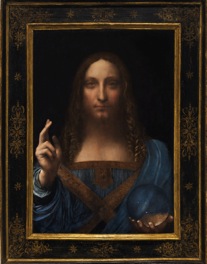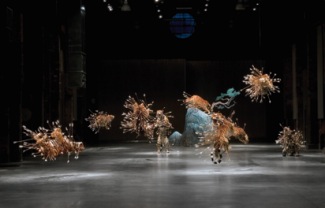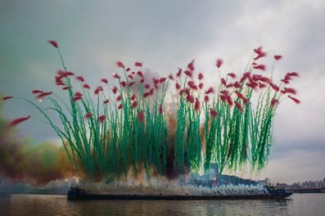
“Even the most art-averse cynic will recognize the blood, sweat and tears that went in to creating this strange and beautiful experience.” – Jordan Hoffman, reviewing Sky Ladder in The Guardian
Check It Out!
By Your Culture Scout
In the 21st century, serious collectors have significantly turned away from old masters and impressionism towards modern art. One of the reasons is an obvious lack of supply- whenever a major old painting comes up at an auction, its price is sky high even if the quality is not so great. Moreover, there are many famous artists whose output is limited and most of it is already locked in museum vaults. It is impossible to collect Vermeer or even Caspar David Friedrich whose body of work would never sustain major collecting. Picasso, with his 50,000 pieces of art, would be much easier to collect if not for the price, but the general collecting trend has now moved even further to the late 20th century and contemporary art. Modern art is being sought and purchased at head-spinning prices, to great extent as an inflation hedge rather than a genuine love of art objects. For every unique and amazing Murakami, there are many weird and plain ugly art expressions that still fetch huge prices simply because they are available for purchase.

This old versus modern art collectors’ dilemma has been recently highlighted by the Nov. 16 auction of a recently rediscovered Da Vinci painting Salvator Mundi. This portrait of Christ was sold in 2005 at an estate sale for $10,000 as an overpainted, badly scraped dark copy of an old painting. Even though it is believed that da Vinci may not have been the sole author of this painting, already badly damaged by multiple restoration attempts, the auction house of Christie’s has pulled all stops in its global marketing campaign to attract a buying frenzy for this unique offering. Once a critical consensus was achieved that Leonardo did indeed put his brush to this portrait, an unusual stiff positioning of a model notwithstanding, this auction became the most important old master sale ever. Christie’s sold the painting for $450 million, well above its predicted minimum guarantee of a $100 million. The interesting thing is that the painting was presented during a contemporary art auction, positioned on the agenda as a lot 9B, somewhere between a Basquiat and a Lithuanian contemporary artist. Why? Christie’s bi-annual modern art sale attracts the most serious and most affluent collectors in the world. It’s the search for modern art that drives the market these days and even if you happen to have a Da Vinci for sale, a contemporary art showcase is the place to find the heavy-weight buyers.
The problem with modern art is that is impossible to collect easily as it is often no longer a piece of painted canvas or a chunk of metal. Many major collectors, like Eli Broad or Marciano Brothers have literally created entire museums around their collections to be able to display properly some huge sculptures and installations. Modern art can provide equally strong emotions and a sense of wonder or surprise as traditional canvases do, but it is certainly less portable.
A great example of such “non-portable,” ephemeral art is the body of work by a very unique, contemporary Chinese artist Cai Guo Qiang. His art is literally explosive. His pictures on paper are images burned into the surface by tiny gunpowder explosions. His art installations or happenings last only seconds or minutes because they are a series of controlled firework explosions. Cai’s one-of-a-kind and fascinating art is the subject of an excellent documentary Sky Ladder directed by Kevin Macdonald.
Cai has had a long road to those current crowning achievements of massive-scale fireworks art installations that made him world famous. He started out as a traditional painter in his native China, and after a decade of work in Japan, he has moved to New York. There he made his name with unforgettable art installations like his dramatic sculptures of tigers pierced with arrows and packs of wild wolves vaulting into space.
 Photo credit: Cai Guo-Qiang, Inopportune: Stage Two 2004, Installation view
Photo credit: Cai Guo-Qiang, Inopportune: Stage Two 2004, Installation view
Photo courtesy of the National Gallery of Canada
These days, Cai is famous as a master of gunpowder. He has taken the knowledge and a tradition of using fireworks from his native Fujian province, where fireworks have accompanied everyday life events for the last 1500 years, and he has elevated this folk tradition and ancient skill to high art.
 Cai Guo-Qiang, Elegy; Explosion event for the opening of Cai Guo Qiang: The Ninth Wave
Cai Guo-Qiang, Elegy; Explosion event for the opening of Cai Guo Qiang: The Ninth Wave
August 8 2014, 8 minutes (ephemeral art)
Photo by Lin Yi, courtesy of Cai Studio
Cai uses gunpowder to burn in complex and abstract images in his framed “paintings,” but he is also a creator of the contemporary art of tri-dimensional installations. His historical fireworks display opened the Beijing Olympic Games in 2008 with a series of 29 giant fireworks fountains over the city skyline, one of column of fire for each past Olympiad.
 Cai Guo-Qiang, Sky Ladder, June 15, 2015, 100 seconds (ephemeral art)
Cai Guo-Qiang, Sky Ladder, June 15, 2015, 100 seconds (ephemeral art)
Photo by Wen-You Cai, Courtesy Cai Studio
Cai Guo-Qiang’s most astounding installation is the one documented in Sky Ladder – literally a fire ladder that goes up 500 meters (1650 feet) straight to the sky. He attempted and failed three times to mount this explosive installation and, thwarted each time by administrative or logistical obstacles, finally attempted it for the fourth time – this time in his native land and without any sponsorship, permit or support. We watch Cai in Sky Ladder as he is reflecting on his previous efforts to realize this lifelong dream of building a ladder to the literal and metaphorical heavens. His time to build the ladder is running out. He wants to show this half-performance and half-pyrotechnical achievement to his 100-year-old grandma who by now is even too weak to visit the remote location. We see logistical preparations, then these dirty and dangerous techniques of handling gunpowder, and finally the amazing result of a fire connection between Earth and Heaven. The same idea that permeated numerous world cultures and religions, here is given a concrete and a successful embodiment. Sky Ladder installation has the power to bring an equally profound meaning and sense of wonder to any art lover, a Bible student or a Chinese historian. The only way to preserve such an ephemeral art expression is through film and the movie Sky Ladder does justice to both the artist and his artistic dream.
Food for the Soul Series
Food for the Soul: Food for the Soul: Geostorm
Food for the Soul: Blade Runner 2049
Food for the Soul: Pacific Standard Time LA/LA
Food for the Soul: Wolf Warrior 2
Food for the Soul: Da Vinci and Salt
Food for the Soul: Valerian or Why Hollywood is Hard to Beat
Food for the Soul: 13 Minutes & Dunkirk
Food for the Soul: Generation Wealth Exhibition
Food for the Soul: Jack Strong
